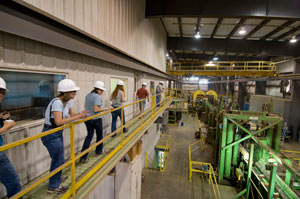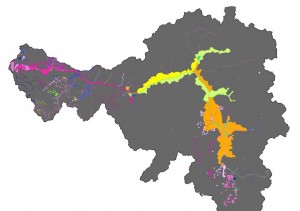The CBC is trying something different in Idaho, something mirrored by changes in USFS management processes at all levels. CFLRP projects are an innovative part of the ongoing development of collaborative partnerships promoted by both the USFS and stakeholder groups as a better way of making land use decisions. The USFS recognizes that the means are as important as the result—indeed, that productive working together is a result in itself: all CFLRP projects must be “developed and implemented through a collaborative process. Put simply, establishment of communication and learning about the priorities of other stakeholders are goals in themselves, along with the restoration work. The CBC is part of this next generation of forest management, following in the steps of the Quincy Library Group and the Beaverhead-Deer Lodge National Forest Partnership.
Ecosystem Research Group, an environmental consulting company based in nearby Missoula, Montana, was contracted in 2012 by the Clearwater Resource Conservation and Development Council to collect existing baseline information as well as to conduct new research on the socio-economic impacts that the CFLRP has had in the project area and nearby communities. Our assessment is quantitative (How many jobs were created or maintained? How many board feet of lumber were harvested?), as well as qualitative. The qualitative element of this study seeks to understand and communicate how quality of life has changed, and if cooperative work has strengthened community bonds in other ways. This report, then, details both the “socio-economic baseline,” the economic and social indicators as they existed in 2009, to provide a sense of the “lay of the land,” and explains the changes that have occurred in this context. We give the statistics and then tell the story behind the numbers, tracing the impacts to individuals in Clearwater, Idaho, and Lewis Counties, and in areas of secondary influence further away from the project area, including into Latah, Nez Perce, Missoula and Ravalli Counties.
This report, along with subsequent addendums, contain the results of our monitoring of both the direct and the indirect economic impacts of the Selway-Middle Fork CFLRP project, including information on several social indicators associated with employment benefits. The information was collected through discussions and follow-up interviews with contractors and indirectly related businesses and organizations. Discussion guides provided detailed data on the quantitative aspects, such as number of workers, hours worked, and amount of wood processed. The interviews also provided a window into important, if not easily quantifiable, ways that the Selway-Middle Fork CFLRP has made a difference in the communities of the Clearwater Basin. Our data collection methodology was designed to be sensitive to small communities and businesses, as many of the existing data sets were designed for larger jurisdictions and economies.



